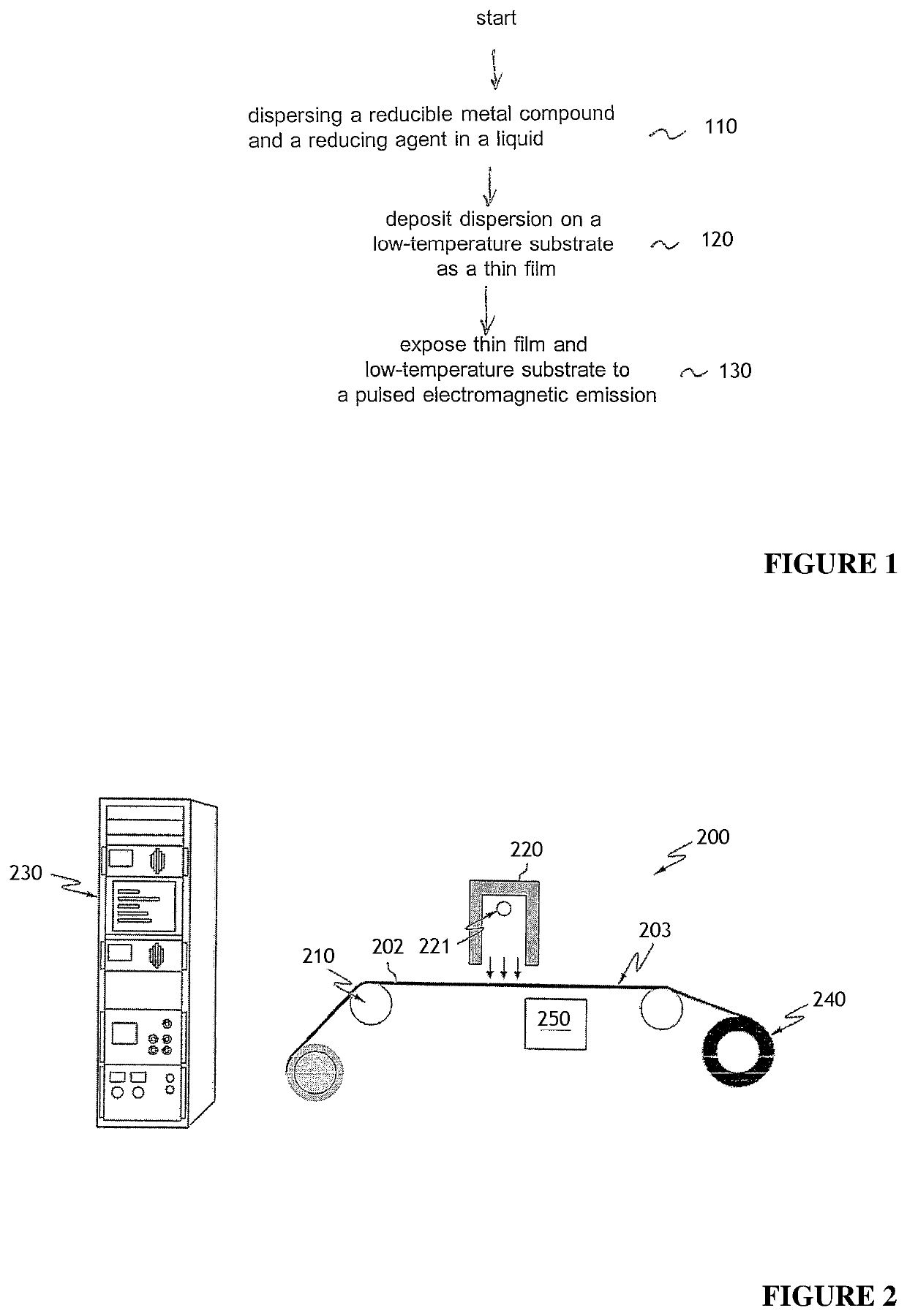Method for reducing thin films on low temperature substrates
a low-temperature substrate and thin film technology, applied in metal-working apparatus, printing, metallic material coating process, etc., can solve the problems of preventing the use of inexpensive substrates, high cost of conductive traces, and limited sintering
- Summary
- Abstract
- Description
- Claims
- Application Information
AI Technical Summary
Benefits of technology
Problems solved by technology
Method used
Image
Examples
example 1
Acid Reducer
[0039]A copper oxide dispersion was produced by mixing 3.0 g<50 nm copper (II) oxide, 3.6 g deionized water, 0.15 g PVP K-30, 0.3 g ethylene glycol, 0.04 g Tergitol® TMN-6, 0.02 g Dynol® 604, 0.02 g BYK®-020, and 0.66 g ascorbic acid in a 20 mL vial. 5 g of zirconium oxide milling media was added and the vial was agitated for 60 minutes.
[0040]The dispersion was applied to a sheet of Melinex® ST505 PET by drawdown using a #5 Meyer bar.
[0041]The sample was cured with a pulse length of 1,000 microseconds, and overlap factor of 2 at 24 feet per minute in an air environment. Although the film was not electrically conductive, the color of the film changed from dark brown to a copper color indicating significant conversion of the copper oxide to copper.
example 2
[0042]A copper oxide dispersion was produced by mixing 2.0 g NanoArc® copper oxide, 5.7 g deionized water, 0.10 g PVP K-30, 0.6 g ethylene glycol, 0.03 g Tergitol® TMN-6, 0.01 g Dynol® 604, and 0.32 g glycerol in a 20 mL vial. 5 g of zirconium oxide milling media was added and the vial was agitated for 60 minutes.
[0043]The dispersion was applied to a sheet of Melinex® ST505 PET by drawdown using a #5 Meyer bar.
[0044]The sample was cured with a pulse length of 850 microseconds, and overlap factor of 2 at 24 feet per minute in an air environment. Although the film was not electrically conductive, the color of the film changed from dark brown to a copper color indicating significant conversion of the copper oxide to copper.
example 3
[0045]A copper oxide dispersion was produced by mixing 2.0 g NanoArc® copper oxide, 5.4 g deionized water, 0.10 g PVP K-30, 0.6 g ethylene glycol, 0.03 g Tergitol® TMN-6, 0.01 g Dynol® 604, and 0.67 g glycerol in a 20 mL vial. 5 g of zirconium oxide milling media was added and the vial was agitated for 60 minutes.
[0046]The dispersion was applied to a sheet of Melinex® ST505 PET by drawdown using a #5 Meyer bar.
[0047]The sample was cured with a pulse length of 1,000 microseconds, and overlap factor of 3 at 24 feet per minute in an air environment. Although the film was not electrically conductive, the color of the film changed from lark brown to a copper color indicating significant conversion of the copper oxide to copper.
PUM
| Property | Measurement | Unit |
|---|---|---|
| temperature | aaaaa | aaaaa |
| thick | aaaaa | aaaaa |
| speeds | aaaaa | aaaaa |
Abstract
Description
Claims
Application Information
 Login to View More
Login to View More - R&D
- Intellectual Property
- Life Sciences
- Materials
- Tech Scout
- Unparalleled Data Quality
- Higher Quality Content
- 60% Fewer Hallucinations
Browse by: Latest US Patents, China's latest patents, Technical Efficacy Thesaurus, Application Domain, Technology Topic, Popular Technical Reports.
© 2025 PatSnap. All rights reserved.Legal|Privacy policy|Modern Slavery Act Transparency Statement|Sitemap|About US| Contact US: help@patsnap.com

